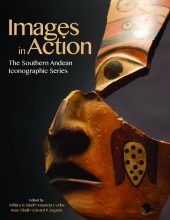Visual database
(a) Front view of a face-neck jar of Paracas Phase 9 style, with mask-like motifs in the Chongos style on the shoulders. Museo de la Nación, Lima.
(b) Back view of a face-neck jar of Paracas Phase 9 style, with mask-like motifs in the Chongos style on the shoulders. Museo de la Nación, Lima.
(a) Face-neck jar of an unusual style combining features of Paracas Phases 9 and 10, with rayed head panels on shoulders and hips. Reported to have been excavated on Cerro Max Uhle in the center of the Ocucaje Basin. TM 91.163.
(b) Face-neck jar of an unusual style combining features of Paracas Phases 9 and 10, with rayed head panels on shoulders and hips. Reported to have been excavated on Cerro Max Uhle in the center of the Ocucaje Basin. TM 91.163.
(c) Face-neck jar of an unusual style combining features of Paracas Phases 9 and 10, with rayed head panels on shoulders and hips. Reported to have been excavated on Cerro Max Uhle in the center of the Ocucaje Basin. TM 91.163.
(a) Two views of a bowl from Rubini Gravelot M, excavated in the Pinilla Sector of the Ocucaje Basin. MRI 430.
(b) Two views of a bowl from Rubini Gravelot M, excavated in the Pinilla Sector of the Ocucaje Basin. MRI 430.
Sheet gold pendant representing a human figure with a rayed head from Paracas Necropolis Burial 114, AMNH 41.2/7511.
Tunic of camelid hair in cream and dark brown, in close-worked looping with a fringe of tufts of unspun camelid hair, created separately and sewn to the main fabric. TM 91.898.
Detail showing four of the ten figures on a double-cloth mantle, allegedly from Paracas Necropolis Burial 349. Several burials in the Necrópolis of Wari Kayan cemetery area include Paracas tradition objects. MNAAHP RT1451.

